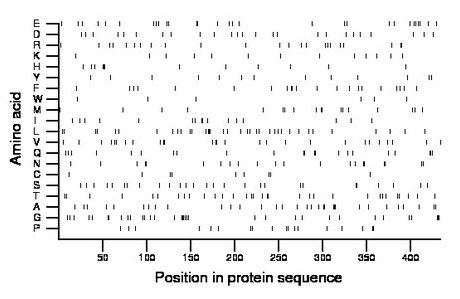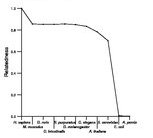
| Name: TUBB4Q | Sequence: fasta or formatted (434aa) | NCBI GI: 55770868 | |
|
Description: tubulin, beta polypeptide 4, member Q
|
Referenced in:
| ||
|
Composition:

Amino acid Percentage Count Longest homopolymer A alanine 7.4 32 3 C cysteine 2.1 9 1 D aspartate 5.8 25 1 E glutamate 6.7 29 2 F phenylalanine 4.8 21 2 G glycine 7.8 34 3 H histidine 2.8 12 3 I isoleucine 3.7 16 2 K lysine 3.0 13 1 L leucine 8.3 36 3 M methionine 4.1 18 2 N asparagine 4.8 21 2 P proline 4.1 18 2 Q glutamine 5.1 22 2 R arginine 5.3 23 2 S serine 6.2 27 2 T threonine 7.4 32 2 V valine 6.2 27 2 W tryptophan 1.4 6 1 Y tyrosine 3.0 13 1 |
Comparative genomics:
Search single species RefSeq proteins at NCBI
Search summary 
Figure data | ||
Related human proteins:Protein Relative score Description Self-match 1.000 tubulin, beta polypeptide 4, member Q TUBB8 0.912 tubulin, beta 8 TUBB2C 0.856 tubulin, beta, 2 TUBB 0.850 tubulin, beta TUBB4 0.849 tubulin, beta 4 TUBB2B 0.848 tubulin, beta 2B TUBB2A 0.844 tubulin, beta 2 TUBB3 0.818 tubulin, beta, 4 TUBB6 0.809 tubulin, beta 6 TUBB1 0.718 beta tubulin 1, class VI LOC100130736 0.403 PREDICTED: similar to tubulin, beta 5 LOC100130736 0.403 PREDICTED: similar to tubulin, beta 5 TUBA1B 0.345 tubulin, alpha, ubiquitous TUBA1C 0.345 tubulin alpha 6 TUBA1A 0.343 tubulin, alpha 1a TUBA4A 0.338 tubulin, alpha 4a TUBA3D 0.337 tubulin, alpha 3d TUBA3C 0.337 tubulin, alpha 3c TUBA8 0.336 tubulin, alpha 8 TUBA3E 0.328 tubulin, alpha 3e TUBAL3 0.319 tubulin, alpha-like 3 TUBG1 0.274 tubulin, gamma 1 TUBG2 0.273 tubulin, gamma 2 TUBE1 0.253 tubulin, epsilon 1 LOC442434 0.186 PREDICTED: similar to hCG1784562 LOC442434 0.186 PREDICTED: similar to hCG1784562 LOC442434 0.186 PREDICTED: similar to hCG1784562 LOC100130736 0.151 PREDICTED: similar to hCG1647990 TUBD1 0.127 delta-tubulin LOC100292044 0.069 PREDICTED: similar to hCG1642465Human BLASTP results (used to prepare the table) | |||
Gene descriptions are from NCBI RefSeq. Search results were obtained with NCBI BLAST and RefSeq entries. When identical proteins are present, the self-match may not be listed first in BLASTP output. In such cases, the table above has been reordered to place it first.
See About the Figures for the scoring system used in the figure above right. The same scoring system was used in the table of BLASTP results.
Guide to the Human Genome
Copyright © 2010 by Stewart Scherer. All rights reserved.
